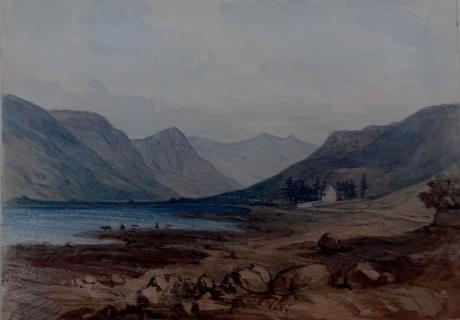page from an album inscribed in the frontispage "F W Staines 3 Uplands St Leonards on Sea"
Amelia Jackson, Nee Staines (1842 – 1925) and thence by descent
Loch Katrine is a freshwater loch in the Trossachs area of the Scottish Highlands, east of Loch Lomond, within the historic county and registration county of Perthshire and the contemporary district of Stirling. The loch is about 8 miles (13 km) long and 1 mile (1.6 km) wide at its widest point, and runs the length of Strath Gartney (Gaelic: Srath Ghartain). It is within the drainage basins of the River Teith and River Forth.
It is a popular scenic attraction for tourists and day-visitors from Glasgow and nearby towns; fly and boat fishing for trout are permitted on the loch from spring to autumn. It also serves as a reservoir for the water supply of the Glasgow conurbation, some 30 miles (48 km) south, being connected by two aqueducts constructed in 1859.
It is the fictional setting of Sir Walter Scott's poem The Lady of the Lake and of the subsequent opera by Gioachino Rossini, La donna del lago.
William Watson, a renowned scholar of Scottish place names, judged Katrine to be "thoroughly Pictish" in origin, and to derive from an extension of the Celtic root *ceit, meaning "dark, gloomy place", a name referring to the loch's heavily forested shores.
The name Katrine has also been hypothesized to represent cateran, from the Gaelic ceathairne, a collective word meaning cattle thief or possibly peasantry.
Francis William Staines was the last of a family of merchants from the City of London. Not only was he a successful businessman but he possessed a large independent fortune, such that he could devote his time to the cultivation of his talents in music and art. He was a brilliant amateur violinist, and also loved to spend much of his time painting. His daughter Amelia and her mother accompanied Mr Staines as he travelled throughout the country finding subjects for his painting. One area of the country that they visited frequently was Scotland and the Lake District, and Amelia grew particularly fond of the dramatic landscape of the Fells. Skelwith Bridge with the view of the hills around it 43 was one of her father’s favourite scenes. He painted landscapes and maritime paintings , exhibited 11 works at the RA including views on the Italian Coast, address in London, Hastings and St Leonards on Sea Susssex.

